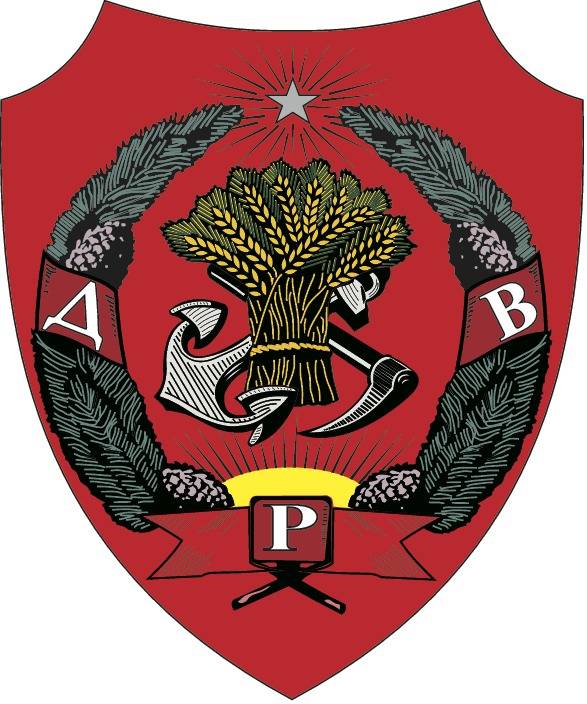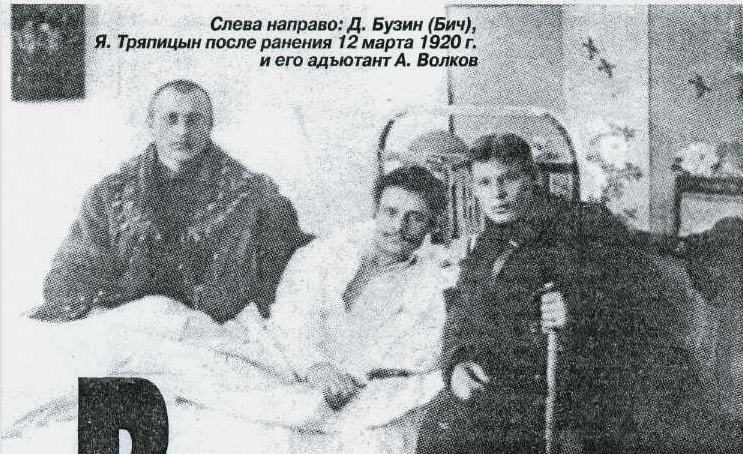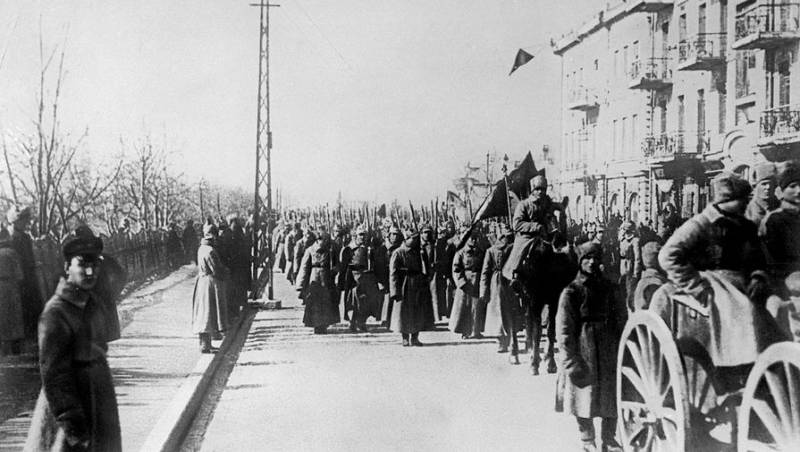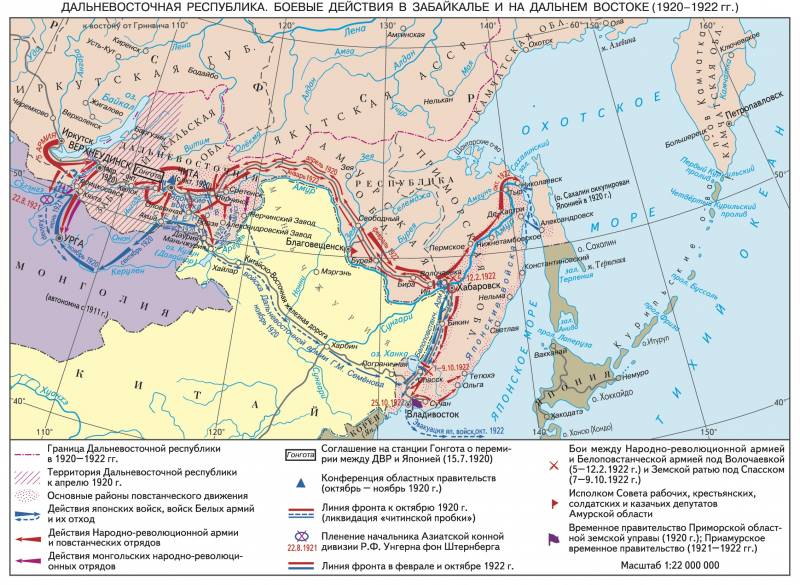Far Eastern Republic and the Japanese threat
100 years ago, in April 1920, the Far Eastern Republic (FER) was established. Formally, it was an independent democratic state, but in fact it was a buffer favorable to Moscow between Soviet Russia and Japan. Thanks to the FER, the Soviet government managed to avoid a dangerous full-scale war with the Japanese Empire and eliminate the last forces of the White movement in the Far East, which were left without serious external support. This was a serious political victory of the Bolsheviks.
General situation
After the defeat of the white armies of Kolchak and the execution of the “supreme ruler” from Baikal to the Pacific Ocean in 1920, a mishmash of governments, authorities and anarchy reigned. On January 31, 1920, an uprising took place in Vladivostok, which led to the fall of power of General Rozanov, who was subordinate to the Kolchak government. The interventionists remained neutral. Rozanov fled to Japan. The interim government of the Far East came to power - the Primorsky regional zemstvo government. The coalition government of the Socialist Revolutionaries, Mensheviks, Zemstvo and Bolsheviks. The white units located in Primorye went over to the side of the new government. Another armed force was the red partisan formations of Sergei Lazo. The former White Guards and the Reds hated each other, but the presence of a third force, the Japanese, forced them to remain neutral.
The Vladivostok government was not opposed to the creation of a democratic buffer republic, but considered itself a power, other governments did not recognize. Local Bolsheviks split on this issue. The members of the Far Eastern Bureau created by Moscow in Vladivostok were I. G. Kushnarev, S. G. Lazo and P. M. Nikiforov. In the Vladivostok group, Kushnaryov spoke for the buffer, and Lazo opposed. The red partisans of Lazo simply proposed cutting out all the "bourgeoisie", without any coalitions. But in Vladivostok they were in the minority, in addition, the Japanese troops interfered. The partisans also occupied Khabarovsk, Blagoveshchensk and other cities of the Amur Region, where they established their regional "governments" and military-revolutionary headquarters. They did not recognize the Vladivostok government. Waged their war for the establishment of Soviet power.
The White Cossacks and the remnants of Kolchakites under General Semenov sat in Chita. Before his arrest, Kolchak handed over to him “the entirety of military and civil power” in eastern Russia. They pressed on the “Chita jam” from two sides: from the west - the East Siberian Soviet Army, from the east - partisans of the East Trans-Baikal Front under the command of Zhuravlev. As a result, the Semenovites (about 20 thousand bayonets and sabers) fought on two fronts: west of Chita and in the areas of Sretensk and Nerchinsk.
The presence of foreign troops in the Far East and Siberia has lost visible legitimacy. In February 1920, a truce was signed between the Soviet government and the Czechoslovak command. Foreign contingents, including Czechs, Poles, Americans, etc., began to withdraw to Vladivostok, and from there they were taken home. During this period, the West decided that the White Cause lost and was not worth the investment. It is necessary to gradually establish ties with the Soviet Republic.
Only Japan led its policy. The Japanese did not want to leave the Far East, still hoping to tear away part of the territory of Russia in their favor, and control the other part with the help of puppet buffer governments. In particular, the Japanese supported the Chita government of the Russian eastern outskirts, headed by Ataman Semenov. Under his command was a fully operational Far Eastern army, which included the remnants of the Kappelites-Kolchakites. The Japanese wanted with the help of Semenovites to create a “black buffer” from Chita to Primorye.
Interestingly, the United States, leaving the Russian Far East, initially untied the Japanese hands. At the end of January 1920, the Americans handed over a memorandum to the Japanese, which stated that Washington would not mind if Japan unilaterally stationed troops in Siberia and continued to provide assistance in operations along the Trans-Siberian Railway and the CER. Although Japan was a competitor to the United States in the Asia-Pacific region, at this stage Washington supported the expansion of the Japanese in the Far East. But in the future, the Americans will help Moscow oust the Japanese from the Far East.
[center] Map source: https://bigenc.ru/
The creation of the Far Eastern Front and the advance of the People's Revolutionary Army
After the liquidation of the regime and the army of Kolchak, Soviet troops (5th Army) stopped in the Baikal region. Its further advance to the east could cause a war with a powerful adversary - the Japanese Empire. The Soviet Republic was in a difficult situation - the war with the White Guards in the south, the war with Poland in the west, the war with Finland in the northwest. It was also impossible to fight Japan with a powerful army and navy. It was necessary to gain time while the “land is burning” under the interventionists and White Guards in the Far East. Build up strength, complete the defeat of the enemy in the European part of Russia, and then go on the offensive in the east of the country.
There were other objective reasons for this step. In the winter of 1919-1920 The Red Army made a powerful leap to the east. However, the occupied territory had to be restored and cleaned up there. The state of Western Siberia, that is, the rear of the Soviet troops, was terrible. Industry, transport and supply systems are destroyed. Cities were threatened by hunger. The typhoid epidemic was raging. Entire villages, trains and military units died out. Thousands of people lay in hospital beds in cities (this was a real epidemic, not the “Chinese virus” of 2020). The peasant war continued to rage. Partisanism and "green" gangs walked with might and main in the taiga.
Thus, before going beyond Baikal, it was necessary to establish elementary order in Siberia. The Bolsheviks simply did not have the strength to establish Soviet power in Transbaikalia and the Far East. Not to mention the war with the Japanese, who had a strong, disciplined army. The formation of the FER solved this problem. Moscow was buying time for a future decisive offensive in the East. In the meantime, the White Guards could be restrained or even smashed by the FER army. This opened up prospects for negotiations with the West. The Entente could now come to an agreement with the democratic government of the Far Eastern Republic, evacuate military and diplomatic missions, and their occupying contingents. Western capitals, which fought for "human rights", were formally satisfied with the establishment of a parliamentary republic.
Based on the current situation, Moscow decided to establish an intermediate state east of Lake Baikal - the Far Eastern People’s Republic (FER). This allowed the gradual liberation of Transbaikalia, Amur Region and Primorye from interventionists and White Guards. On the other hand, non-communist forces (Irkutsk Political Center, Socialist-Revolutionaries) wanted to create a parliamentary republic free from the "dictatorship of the proletariat." The Socialist-Revolutionaries and other parties hoped that the creation of a democratic republic would save the eastern part of Russia from the Japanese occupation and from the power of the Bolsheviks.
To guide the work in March 1920, the Far Eastern Bureau of the RCP (B.) Was specially formed, whose members, A. A. Shiryamov, A. M. Krasnoshchekov and N. K. Goncharov, were sent to Verkhneudinsk (modern Ulan-Ude) to organize new state. FER was proclaimed on April 6, 1920 by the Constituent Congress of Workers of the Baikal Region. The congress adopted a constitution according to which power belonged to the working people. The capital was Verkhneudinsk. The government was headed by Alexander Krasnoshchekov. The supreme authority was the People’s Assembly of the Far Eastern Democratic Republic (National Council of the Far East), it was created on the basis of elections for a period of two years. In between the sessions, the Presidium of the National Council of the FER worked. The popular assembly was multi-party: the communists and the adjacent peasant fraction (majority), the fraction of prosperous peasants (kulaks), Socialist-Revolutionaries, Mensheviks, Cadets, people's socialists and the Buryat-Mongol fraction. The National Assembly elected the government.
At the time of its establishment, the FER included the Amur, Transbaikal, Kamchatka, Primorsky and Sakhalin regions. However, the de facto FER government did not have power over much of the territory. In Transbaikalia the white government of Semenov settled. In the Amur Region, Primorye and Kamchatka, local pro-Soviet autonomous governments operated - the Executive Committee of the Council of Workers, Peasants, Soldiers and Cossack Deputies with a center in Blagoveshchensk, the Provisional Government of the Primorsky Regional Zemstvo Administration with a center in Vladivostok. Part of the territory of the Far East, including Northern Sakhalin, was occupied by Japanese troops. As a result, the FER leadership initially controlled only the western part of the Trans-Baikal region. Only in August 1920, the Executive Committee of the Council of Workers, Peasants, Soldiers and Cossack Deputies of the Amur Region obeyed the FER government.
Soviet Russia in May 1920 recognized the FER and provided it with political, financial, material, personnel and military assistance. On the basis of the East Siberian Soviet Army (it was formed on the basis of the People's Revolutionary Army of the Irkutsk Political Center, from partisans, rebels, workers' squads and surrendered Kolchak members of Eastern Siberia) in March 1920, the People's Revolutionary Army (NRA) of the Baikal region was created, in April - the NRA Transbaikalia, in May - NRA DVR. It was reinforced from the rear by the 5th Soviet Army, there were no problems with command personnel (Soviet) and weapons, all the warehouses of Kolchak's dead army remained in the hands of the Reds. The main task of the NRA was the return of the Far East of Soviet Russia and the destruction of whites in Transbaikalia and the Amur region. The size of the army in the fall of 1920 was about 100 thousand people. The army was led by Heinrich Eikhe, a former tsarist officer who joined the ranks of the Red Army after the revolution and commanded a regiment, brigade, 26th Infantry Division and 5th Soviet Army on the Eastern Front.
At the beginning of March 1920, the East Siberian Army suppressed the Semenovites and occupied the Baikal region with the city of Verkhneudinsky. This city became the capital of the Far East. In April - early May 1920, the People's Revolutionary Army of the Far Eastern Democratic Republic Eihe made two attempts to drive out the Far Eastern army of Semenov from Transbaikalia (Chita operations). On the eastern flank, units of the Amur Front were advancing under the command of Shilov, which was formed on the basis of the partisan East Transbaikal Front and included the districts of Olovyannaya, Nerchinsk, Nerchinsky Plant, Sretensk and Blagoveshchensk (from May - and Khabarovsk). However, the NRA was unable to take Chita. On the one hand, the Reds did not have decisive superiority in these operations, the forces were approximately equal. On the other hand, the Kappelites were selected troops of the White Army, and the first attempts of the Reds to eliminate the “Chita jam” were repulsed. In addition, the White Guards were supported by Japanese troops (5th Infantry Division), they occupied the main communications, which hindered the actions of the Reds, who could not fight the Japanese.


Japanese invasion
As a reason for aggression, the Japanese used the "Nikolaev incident" - a conflict between the red partisans and Japanese troops in Nikolaevsk-on-Amur in mid-March 1920. During the collapse of the Kolchak regime, some partisan detachments led by Lazo moved to Vladivostok, others to the lower reaches of the Amur. These formations were led by Yakov Tryapitsyn, a former tsarist officer, Soviet and partisan commander, and Lebedeva-Kiyashko. In February, parts of Tryapitsyn occupied Nikolaevsk-on-Amur, where they proclaimed the creation of the Far Eastern Soviet Republic as part of the lower reaches of the Amur, Sakhalin, Okhotsk and Kamchatka. The Red Army of the Nikolaev district is formed.
On March 11-12, 1920, a local Japanese detachment, with the support of the local Japanese community, attacked Tryapitsyn’s troops. The Reds lost about 150 killed, over 500 wounded. Tryapitsyn himself was wounded, his deputy Mizin and Chief of Staff Naumov died. However, the red partisans quickly came to their senses, pulled up reinforcements, gained numerical superiority and completely destroyed the Japanese garrison by March 15. Died and the Japanese colony.
The news of this massacre shocked Japan and was used by the military-political leadership as a pretext for a full-scale invasion. On the night of April 4-5, 1920, the Japanese attacked the Reds in the Far East. The Japanese defeated the red partisans from Vladivostok to Khabarovsk. On the Lower Amur, Tryapitsyn evacuated Nikolaevsk and burned the city. The Japanese occupied North Sakhalin. In the region, occupying Japanese power is being established. Only in Vladivostok killed about 7 thousand military and civilians. Among the dead was the famous Bolshevik and the red commander Seryi Lazo. Japan introduced an army into the Russian Far East - over 170 thousand bayonets. True, the Japanese did not disperse their forces; they did not go deep into the Russian territory outside the main communications. But all the main points and communication centers occupied their garrisons.

- Alexander Samsonov
- Smoot. 1920 year
Battle of Rostov
The disaster of white Odessa
How Slashchev Crimea defended
Dono-Manych battle
The death of the Northern Army Miller
Why Western agent Kolchak is turned into a hero and martyr of Russia
The defeat of the army of Denikin in the battle of Tikhorets
How did the Ice Siberian campaign end
The fall of the White Kuban
Agony of White Novorossiysk
The death of the Kuban army
Denikin's resignation


Information